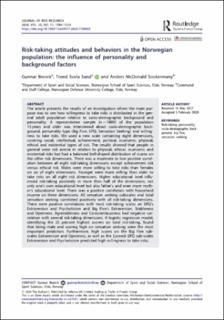| dc.contributor.author | Breivik, Gunnar | |
| dc.contributor.author | Sand, Trond Svela | |
| dc.contributor.author | Sookermany, Anders McDonald | |
| dc.date.accessioned | 2021-02-01T09:35:21Z | |
| dc.date.available | 2021-02-01T09:35:21Z | |
| dc.date.created | 2020-04-26T00:30:19Z | |
| dc.date.issued | 2020 | |
| dc.identifier.citation | Journal of Risk Research. 2020, 23(11), 1504-1523. | en_US |
| dc.identifier.issn | 1366-9877 | |
| dc.identifier.uri | https://hdl.handle.net/11250/2725497 | |
| dc.description | This is an Open Access article distributed under the terms of the Creative Commons Attribution-NonCommercial-NoDerivatives License (http://creativecommons.org/licenses/by-nc-nd/4.0/), which permits non-commercial re-use, distribution, and reproduction in any medium, provided the original work is properly cited, and is not altered, transformed, or built upon in any way. | en_US |
| dc.description.abstract | The article presents the results of an investigation where the main purpose was to see how willingness to take risks is distributed in the general adult population relative to socio-demographic background and personality. A representative sample (n = 1000) of the population 15 years and older was interviewed about socio-demographic background, personality type (Big Five, EPQ, Sensation Seeking) and willingness to take risks. We used a new scale containing eight dimensions, covering social, intellectual, achievement, political, economic, physical, ethical and existential types of risk. The results showed that people in general were risk averse in relation to physical, ethical, economic and existential risks but had a balanced bell-shaped distribution of scores on the other risk dimensions. There was a moderate to low positive correlation between all eight risk-taking dimensions except achievement risk versus ethical risk. Males were more willing to take risks than females on six of eight dimensions. Younger were more willing than older to take risks on all eight risk dimensions. Higher educational level influenced risk-taking positively in more than half of the dimensions, not only one’s own educational level but also father’s and even more mother’s educational level. There was a positive correlation with household income on three dimensions. All sensation seeking subscales and total sensation seeking correlated positively with all risk-taking dimensions. There were positive correlations with most risk-taking scales on EPQ’s Extraversion and Psychoticism and Big Five’s Extraversion, Stableness and Openness. Agreeableness and Conscientiousness had negative correlation with several risk-taking dimensions. A logistic regression model, identifying the 25 percent highest scorers on total risk-taking, found that being male and scoring high on sensation seeking were the most important predictors. Furthermore, high scores on the Big Five sub-scales Extraversion and Openness, as well as the Eysenck EPQ sub-scales Extraversion and Psychoticism predicted high willingness to take risks. | en_US |
| dc.language.iso | eng | en_US |
| dc.relation.uri | https://www.tandfonline.com/doi/full/10.1080/13669877.2020.1750455 | |
| dc.subject | risk-taking | en_US |
| dc.subject | personality | en_US |
| dc.subject | socio-demographic background | en_US |
| dc.subject | big five | en_US |
| dc.subject | sensation seeking | en_US |
| dc.title | Risk-taking attitudes and behaviors in the Norwegian population: the influence of personality and background factors | en_US |
| dc.type | Peer reviewed | en_US |
| dc.type | Journal article | en_US |
| dc.description.version | publishedVersion | en_US |
| dc.rights.holder | © 2020 The Author(s) | en_US |
| dc.source.pagenumber | 20 | en_US |
| dc.source.journal | Journal of Risk Research | en_US |
| dc.identifier.doi | 10.1080/13669877.2020.1750455 | |
| dc.identifier.cristin | 1808058 | |
| dc.description.localcode | Institutt for idrett og samfunnsvitenskap / Department of Sport and Social Sciences | en_US |
| cristin.ispublished | true | |
| cristin.fulltext | original | |
| cristin.qualitycode | 1 | |
